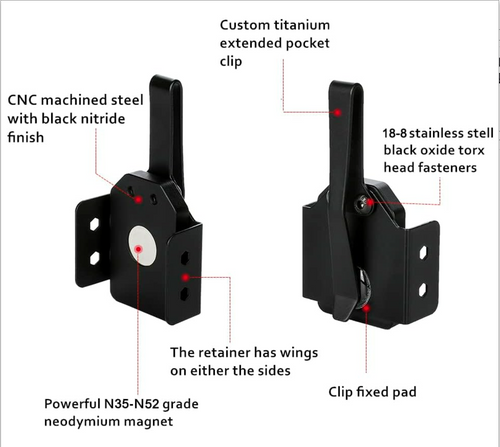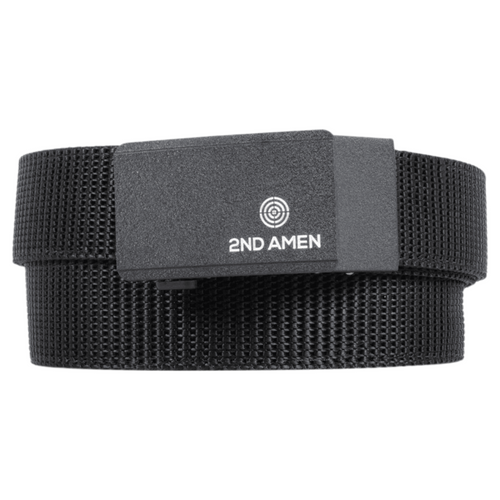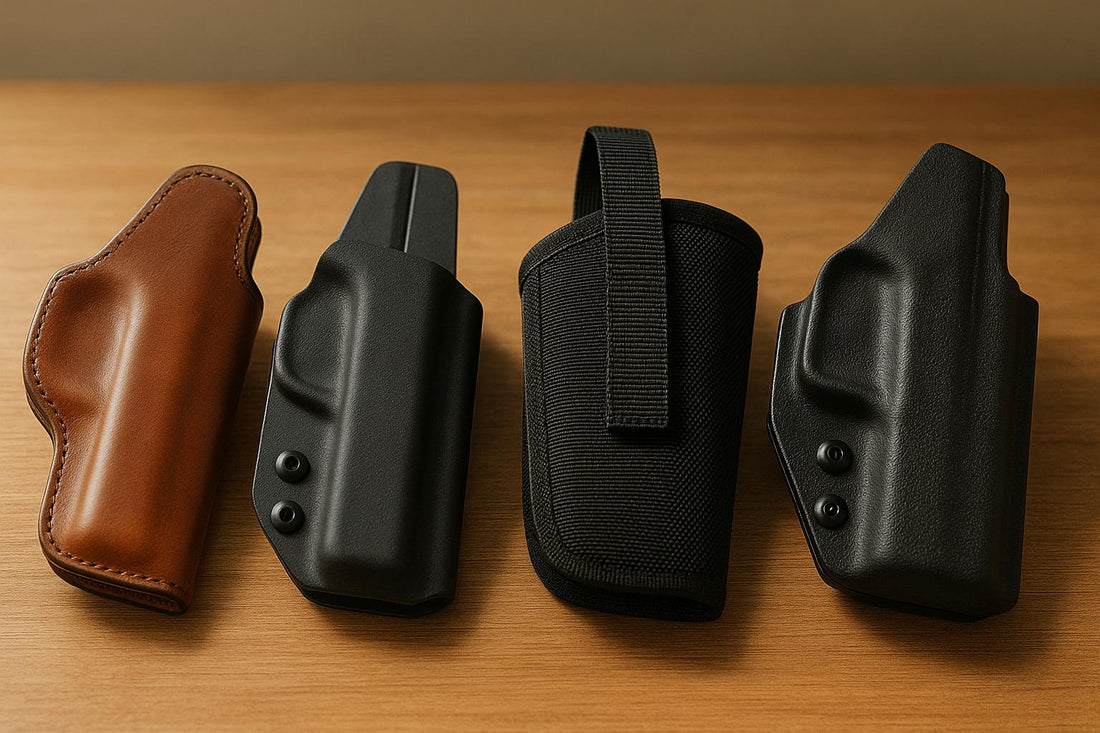Holster materials directly impact how long they last and how well they perform. Here's a quick breakdown of the four main materials - leather, Kydex, nylon, and polymer - and how they compare in durability, weather resistance, upkeep, and cost:
- Leather: Durable and molds to your firearm over time but requires regular care to prevent cracking. Best for controlled environments. Costs $50–$200+.
- Kydex: Extremely durable, weather-resistant, and low-maintenance. Ideal for humid or demanding conditions. Costs $30–$100.
- Nylon: Affordable and lightweight but prone to wear and fraying over time. Needs extra care to maintain durability. Costs $15–$50.
- Polymer: Long-lasting, weatherproof, and low-maintenance. Great for extreme conditions. Costs $30–$100.
Quick Comparison Table
| Material | Durability | Weather Resistance | Maintenance | Cost | Lifespan |
|---|---|---|---|---|---|
| Leather | High | Moderate | High | $50–$200+ | 10+ years |
| Kydex | Highest | Excellent | Low | $30–$100 | 10–20 years |
| Nylon | Moderate | Good (if treated) | Low | $15–$50 | 3–5 years |
| Polymer | High | Excellent | Low | $30–$100 | 10–20 years |
Key takeaway: Leather offers timeless style and comfort with proper care, while Kydex and polymer excel in durability and weather resistance. Nylon is a budget-friendly option but has a shorter lifespan. Choose based on your environment, usage, and maintenance preferences.
Leather VS KYDEX Holster | Which Is Better For Long Term SHTF?
1. Leather Holsters
Leather holsters are known for their durability and ability to adapt over time. With proper care, they mold naturally to both the firearm and the wearer’s body, creating a fit that gets better the more you use it.
When maintained correctly, leather holsters can last for decades, often outliving synthetic options. This longevity depends on regular care, including cleaning and conditioning, which helps prevent cracking, warping, or losing retention.
One downside of leather is its sensitivity to moisture. Extended exposure to water can lead to warping, stiffness, or even mold and mildew. To keep your holster in top shape, store it in a cool, dry area away from direct sunlight. Routine maintenance not only keeps the holster functional but also ensures you get the most out of your investment.
High-quality leather holsters are crafted with precision and often come with a higher price tag than synthetic alternatives. However, their long-lasting nature makes them a worthwhile choice.
The break-in period is another advantage, as it enhances comfort and reduces stress on the seams, further boosting the holster’s lifespan.
Brands like Houdini Holsters even offer lifetime guarantees on their custom leather holsters, emphasizing their craftsmanship and reliability.
Maintenance Schedule for Maximum Longevity
| Maintenance Task | Frequency | Purpose |
|---|---|---|
| Basic Cleaning | Weekly | Remove dirt and debris |
| Conditioning | Monthly | Prevent drying and cracking |
| Deep Cleaning | Quarterly | Remove embedded oils and residue |
| Retention Check | Monthly | Ensure proper firearm fit |
| Hardware Inspection | Quarterly | Check fasteners and tightness |
Although leather holsters demand more upkeep than synthetic ones, their ability to conform to your firearm and body, paired with a classic, timeless look, makes them a favorite for those seeking long-term use.
2. Kydex Holsters
Kydex holsters are known for their toughness and ease of maintenance. Made from a durable thermoplastic material, they hold their shape for years, making them a dependable option for long-term use.
One standout feature of Kydex is its resistance to moisture. Unlike leather, it doesn't absorb rain, sweat, or humidity, which means it won't degrade over time due to exposure to the elements. This weatherproof quality ensures reliable performance in a variety of climates and conditions.
Another big plus? Kydex holsters are incredibly low-maintenance. Usually, all it takes to keep them clean is a quick wipe with a damp cloth or a mild soap solution. This simplicity makes them a practical and cost-effective choice for everyday carry.
When it comes to retention, Kydex holsters shine. Their custom-molded designs provide a snug, secure fit for your firearm, eliminating the need for constant adjustments. This feature is especially valuable for tactical users and law enforcement professionals who rely on consistent performance.
While a high-quality Kydex holster typically costs between $40 and $100, its durability and minimal upkeep make it a worthwhile investment. Some premium brands, like Houdini Holsters, even offer lifetime guarantees, showcasing their confidence in the material's long-lasting performance.
What makes Kydex holsters so durable? Here are some key factors:
- Resistance to impacts and rough handling
- No risk of moisture-related damage
- Reliable retention over time
- Gentle on firearm finishes
- Stability in extreme temperatures
To maximize the lifespan of a Kydex holster, it's a good idea to occasionally check retention points and hardware connections. However, these inspections are generally less frequent compared to those needed for leather holsters. Thanks to its strength and ability to withstand harsh conditions, Kydex is an excellent choice for those who carry daily in demanding environments. Next, we'll take a closer look at how nylon holsters compare in terms of durability.
3. Nylon Holsters
Nylon holsters are a lightweight and affordable choice, often favored for casual use or as a backup option. While they’re easy on the wallet, nylon tends to wear down at stress points over time, leading to fraying that can affect both its look and functionality.
When it comes to moisture, nylon does a decent job handling light exposure. However, it can absorb water if left wet, which weakens the material. This makes proper drying and care essential to maintain its condition.
To keep a nylon holster in good shape, here are some basic maintenance tips:
- Check regularly for fraying or loose stitching.
- Clean gently with a damp cloth to remove dirt.
- Ensure it’s completely dry after any exposure to moisture.
- Use a fabric protector occasionally to enhance durability.
One of the main appeals of nylon holsters is their low cost, which makes them a practical choice for backup use. However, their shorter lifespan means you might need to replace them more often compared to other materials.
Here’s a quick look at how nylon performs in key areas:
| Aspect | Performance | Impact on Longevity |
|---|---|---|
| Daily Wear | Moderate wear; visible signs over time | Shows wear with regular use |
| Moisture Resistance | Handles light moisture but absorbs water if wet | Requires extra care to avoid material weakening |
| Heat Tolerance | Good; holds shape under normal conditions | Performs well in typical temperature ranges |
| Structural Integrity | Moderate; depends on quality and upkeep | Can degrade under heavy or prolonged stress |
Nylon’s lightweight nature makes it comfortable to carry, but it may not offer the same retention or durability as other materials. Features like reinforced stitching and water-resistant treatments can help extend its lifespan, but overall quality can vary significantly.
Up next, we’ll dive into polymer holsters and see how they stack up in comparison.
sbb-itb-7fb5bb8
4. Polymer Holsters
Polymer holsters are known for their durability and reliable firearm retention, making them a popular choice for both law enforcement and civilian carriers. These holsters are crafted from synthetic materials specifically designed to withstand the rigors of daily use.
One of the standout features of polymer holsters is their ability to maintain shape and functionality over time. Unlike other materials that may wear down or lose their structure, polymers hold up exceptionally well, even after years of consistent use. This durability ensures that they remain dependable, no matter how demanding the conditions.
When it comes to handling tough environments, polymer holsters shine. Here's a look at how they perform under various conditions:
| Environmental Factor | Performance Impact | Longevity Benefit |
|---|---|---|
| Moisture Exposure | No absorption | No risk of damage from humidity |
| Temperature Changes | Maintains shape in extreme heat or cold | Reliable performance year-round |
| UV Radiation | Minimal fading with care | Retains structural integrity |
| Physical Stress | High impact resistance | Resists cracking and deformation |
Another advantage of polymer holsters is their low maintenance. A quick wipe-down is usually all it takes to keep them clean and functional, making them incredibly easy to care for.
Polymer holsters also offer a great balance between cost and durability. They’re typically priced between basic nylon holsters and premium leather options, but their long lifespan often makes them a more economical choice in the long run.
When selecting a polymer holster, it’s worth paying attention to a few key features to ensure maximum durability and performance:
- Retention System: Opt for adjustable retention that holds steady over time.
- Molding Quality: Look for precise firearm fit and smooth, finished edges.
- Construction: Reinforced stress points and quality mounting hardware are essential for longevity.
One feature many users appreciate is the audible "click" when the firearm is seated in the holster, giving an added sense of security and consistent retention.
While polymer holsters might not offer the same level of comfort as leather during extended wear, many modern designs now include ergonomic features to bridge the gap. These innovations make polymer holsters a practical and durable choice for firearm carriers, setting the stage for further comparisons with other materials.
Material Comparison Chart
Here's a quick reference guide to help you evaluate holster materials based on their durability and performance.
Key Performance Comparison
| Material Feature | Leather | Kydex | Nylon | Polymer |
|---|---|---|---|---|
| Expected Lifespan | 10+ years | 10–20 years | 3–5 years | 10–20 years |
| Wear Resistance | High (with care) | Very high | Moderate | High |
| Weather Protection | Limited | Excellent | Moderate | Excellent |
| Heat Stability | Moderate | Excellent | Good | Excellent |
| Upkeep Level | High | Minimal | Low | Minimal |
| Fit & Retention | Improves with use | Excellent | Fair | Very good |
Advantages and Limitations
Here’s a breakdown of each material’s main strengths and drawbacks:
| Material | Key Strengths | Primary Limitations |
|---|---|---|
| Leather | Molds to body, ages beautifully, classic look | Needs regular conditioning, sensitive to moisture, prone to stretching |
| Kydex | Consistent fit, weatherproof, low upkeep | Can feel stiff initially |
| Nylon | Lightweight, budget-friendly, quick break-in | Wears out quickly, loose retention, can fray |
| Polymer | Durable, keeps shape, handles weather well | Quality varies depending on manufacturer |
Environmental Factors
Different environments can affect holster materials in unique ways. Here's how they stack up:
| Environmental Factor | Best Performing Materials | Impact on Longevity |
|---|---|---|
| High Humidity | Kydex, Polymer | Maintains structure and resists moisture |
| Extreme Heat | Kydex, Polymer | Holds shape up to 200°F |
| UV Exposure | Leather, Polymer | Minimal degradation |
| Daily Wear | All Materials | Depends on care and maintenance |
| Salt Exposure | Kydex, Polymer | Resists corrosion |
When selecting a holster, consider how your environment and daily use will affect its longevity. While leather and Kydex or polymer holsters may cost more upfront, their durability often makes them a worthwhile investment over time.
Best Materials By Use Case
When choosing a holster, the material should align with your specific needs. Beyond durability and maintenance, understanding how different materials perform in various scenarios can help you make the best choice. Here's a breakdown of which materials shine under specific conditions:
Daily Concealed Carry
For everyday concealed carry, Kydex stands out for its durability and secure retention. On the other hand, premium leather offers a snug, custom fit as it molds to your body over time. A good example is the Breakout 2.0 IWB holster from Houdini Holsters, designed for all-day comfort and reliability.
High-Activity Use
If you're constantly on the move, you'll need a holster that can keep up with your lifestyle. Here’s a quick guide:
| Activity Level | Best Material | Key Benefits |
|---|---|---|
| Tactical/Professional | Kydex | Secure retention and weather-resistant design |
| Outdoor/Hunting | Polymer | Handles moisture well and requires little upkeep |
| Competition | Kydex/Polymer | Consistent draw with excellent retention |
Climate-Specific Choices
Different environments demand materials that can handle the elements effectively. Here's what works best:
| Environment | Recommended Material | Why It Works |
|---|---|---|
| Humid Climate | Kydex/Polymer | Resists moisture and prevents corrosion |
| Hot Climate | Kydex | Maintains its shape in high temperatures |
| Variable Weather | Polymer | Stable across a wide range of temperatures |
Budget-Conscious Options
If you're working within a budget, there are still great materials to consider:
- Nylon: The most affordable option, though it has a shorter lifespan.
- Kydex: A middle-ground choice, offering durability at a reasonable cost.
- Premium Leather: More expensive upfront but delivers long-term value with proper care.
Professional Use
For professionals who need absolute reliability, material choice is crucial. Holsters made from Kydex or polymer provide excellent retention and a solid, rigid structure. These materials are ideal for tactical roles, law enforcement, or open carry situations where secure firearm retention is non-negotiable.
FAQs
What factors should I consider when choosing a holster material for my needs?
Choosing the right holster material is all about matching it to your environment, how you plan to use it, and your personal preferences. The most common materials - leather, Kydex, and nylon - each bring their own strengths to the table:
- Leather: Known for its durability and ability to mold to your firearm over time, leather offers a timeless look and a snug, comfortable fit.
- Kydex: A rigid, tough material that's perfect for secure retention and quick access, making it a favorite for many.
- Nylon: Lightweight and flexible, nylon works well for casual or temporary use where comfort is key.
When choosing a holster, consider factors like durability, comfort, and concealment. For example, if you’re looking for an everyday concealed carry option, you’ll likely want something that’s both comfortable to wear and easy to access when needed.
If you're searching for a reliable option, Houdini Holsters crafts custom handmade holsters that strike a balance between comfort, concealment, and performance. Take their Breakout 2.0 IWB holster as an example - it’s made in the USA, comes with a lifetime guarantee, and is built to meet a variety of needs while delivering lasting quality.
What are the best ways to maintain a leather holster for long-lasting durability?
To keep your leather holster looking great and performing well for years, regular care is essential. Start by cleaning it periodically with a damp cloth to wipe away dirt and grime. Just be careful not to soak it, as too much water can harm the leather. Next, condition the leather with a quality leather conditioner to keep it supple and avoid cracks. Use a small amount and follow the instructions on the product for best results.
When it comes to storage, choose a cool, dry spot away from direct sunlight or extreme heat. Too much exposure to these elements can weaken the leather over time. With a little routine maintenance, your holster can stay functional and stylish for years to come.
What are the key differences in retention and fit between Kydex and leather holsters?
The material of a holster plays a big role in its retention and fit. Kydex holsters, made from a rigid thermoplastic, are known for their strong retention. Thanks to their molded design, they securely grip your handgun, ensuring a consistent draw every time. Plus, they hold their shape over time, making them a solid choice for anyone focused on durability and precision.
In contrast, leather holsters bring flexibility and comfort to the table. Over time, the leather molds to the shape of your firearm and your body, giving you a personalized fit. However, as leather softens with use or exposure to the elements, it can lose some of its retention.
When deciding between the two, think about what matters most to you. If you’re after a tough, precise fit, Kydex might be the way to go. But if you value comfort and a more traditional style, leather could be a better match. For a premium option, take a look at Houdini Holsters. They offer custom handmade holsters that balance comfort and functionality, all backed by a lifetime guarantee.




